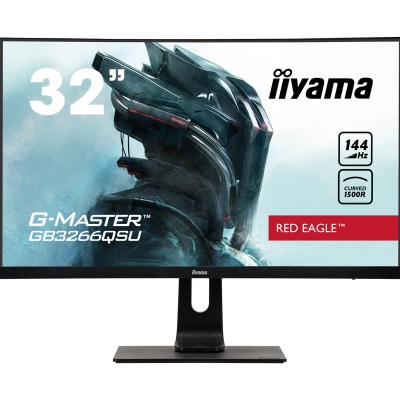MSI Optix MPG321QRF-QD Gaming Monitor Review: Dramatic Design, Solid Features
MSI’s panel is big, bold, and packed with features, although its gamer styling lacks maturity.

This review comes courtesy of: 
Subscribe to the magazine here.
MSI is clearly targeting stereotypical gamers with the styling of its Optix MPG321QRF-QD ($449/£399). Its plastic rear mimics brushed metal and carbon fiber, it sits on a dramatically angled base and around the back you’ll find RGB LEDs. Happily, the Optix backs up the dramatic design with practical features.
The stand offers 100mm of height adjustment alongside swivel and tilt movement, as well as a cable-routing cut-out. Around the back there are two HDMI 2 ports, a DisplayPort 1.4 input, and a USB Type-C connection that also handles DisplayPort. There are also three USB 3.2 Gen 1 ports, two of which are helpfully located on the left-hand bezel.
Meanwhile, a handy joystick navigates an excellent on-screen display – it’s fast, well organized, and clearly displays key information and the impact to expect when you change different settings. The MSI’s final big feature is its most surprising – a KVM switch. These are usually found on business screens, and allow users to control two devices with one set of peripherals – handy for switching between a PC and laptop.
There are good gaming credentials, too. The MSI’s 32in IPS screen has a 165Hz default refresh rate that overclocks to 175Hz and it supports FreeSync and G-Sync. Its 2,560 x 1,440 resolution is good for mainstream gaming too, but it’s not particularly crisp on a 32in screen – you can easily see the pixels if you look closely.
Build quality is middling as well. Its plastic rear feels weak, it’s not a tool-free build, and the monitor is heavy. LG’s rival UltraGear 32GP850 packs a punch against it too – it has the same core specification as the MSI alongside a 180Hz overclocked refresh rate, a sturdier, more mature design, and a cheaper $399/£349 price.
The MSI pairs its adaptable design with bold colors, though. This screen rendered 99 percent of the sRGB gamut with a monster 167.4 percent volume, and the default contrast ratio of 1,127:1 is good. Those figures mean colors are delivered with huge vibrancy and decent depth.
There’s no clear ghosting or inverse ghosting when the panel runs at its default 165Hz refresh rate, and there’s hardly any halo around objects either. While this screen doesn’t have the speed to sate high-end esports players, it’s fast enough to tackle mainstream esports and single-player games. Moving to 175Hz only has a tiny impact, and we’d avoid the MPRT Sync option – it creates ghosting and darkens the display.
The MSI is a bit ordinary in some other areas, however. Its delta E of 4.14 is mediocre, and the color temperature of 6,143K is on the warm side. The peak brightness of 600cd/m² and lack of high-end dimming means this screen isn’t good enough for HDR gaming, either.
The rival LG is sometimes better. Its colors are more accurate than the MSI, and it offers similar gamut performance alongside a reasonable contrast ratio of 900:1. Its output is more realistic, and better if you want to enjoy gritty games or need a panel for creative work.
Verdict
The MSI is pricier than the LG, and not everyone will appreciate its bright, bold visual output. There’s no denying its vibrancy, though, and it impresses with loads of features and an eye-catching design. With a recent drop in price to just $449/£399, the Optix is now well priced too. It isn’t the most mature-looking gaming display, but it’s bold, absorbing, and has loads of features – it’s ideal if you want a versatile, striking screen.
Pros
+ Punchy colors
+ Loads of features
+ Decent mainstream refresh rate
+ Great OSD
Cons
– Mediocre color accuracy
– Tricky to build
Specs
Screen size
32in
Resolution
2,560 x 1,440
Panel technology
IPS
Maximum refresh rate
165Hz (175Hz overclocked)
Stated response time
1ms
Stated contrast ratio
1,000:1
Active sync
AMD FreeSync Premium, Nvidia G-Sync compatible
Display inputs
1 x DisplayPort 1.4a, 2 x HDMI 2b
Audio
N/A
Stand adjustment
Height, tilt, swivel
Extras
100 x 100mm VESA mount, 2 x USB-C 3.2 Gen 1, KVM
HDR standard
VESA DisplayHDR 600

